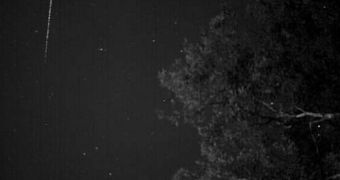Astronomers say that they may have discovered the trails left behind by a comet passing through our neighborhood recently. The object itself has yet to be identified, but researchers say that it could pose a threat to our planet.
Investigators base their conclusions on an analysis of a surprising meteor shower, that appeared out of the blue this February. They say that the space debris were very likely ejected from a passing comet, that may have flown close by our planet.
In an announcement made on Wednesday, July 27, experts say that this space object could potentially be very dangerous, and that it needs to be found and analyzed. Calculating its orbit should provide us with the insight we need on its “intentions.”
The shower that astronomers observed on February 4 was made up of small meteoroids, which only fell to the ground for a few hours. Monitoring equipment indicated that the debris originated in the direction of the star Eta Draconis, Space reports.
As such, the shower was named the February Eta Draconids (FED). By carefully studying their traits, researchers determined that the debris may have very well been produced by a long-period comet.
These objects' paths and timing are notoriously difficult to predict, as they do not follow a steady orbit, and only a few of them are known to science. These objects may spend most of their time in the outer solar system, and only visit the interior portions at rare intervals.
“If the meteoroids can hit us, so can the comet. We don’t know whether the comet has already passed us by or is still on approach,” says Peter Jenniskens, the Search for Extraterrestrial Intelligence (SETI) Institute expert found discovered FED.
He also holds an appointment as a researcher at the NASA Ames Research Center (ARC), in Moffett Field, California. The investigator adds that the chances of a comet hitting us are remote, but explains that this should not imply that we should not know about potential threats.
The discovery again highlights the need for an advanced early detection and warning system for asteroids and comets. Compared to other telescopes and observatories, constructing the instruments needed to survey the sky for space rocks is relatively inexpensive.
Two telescopes, situated opposite to each other on the planet, could easily keep track of the night sky, conducting non-stop monitoring on Earth's neighborhood. If a comet or asteroid do pose a threat, they could be detected well in advanced, leaving us with enough room to mount an effective response.

 14 DAY TRIAL //
14 DAY TRIAL //